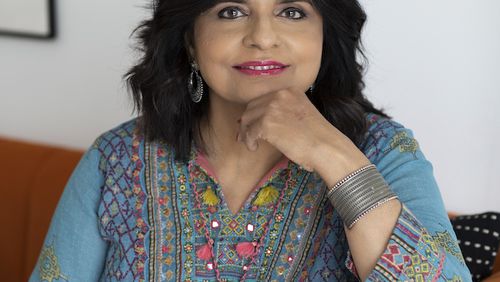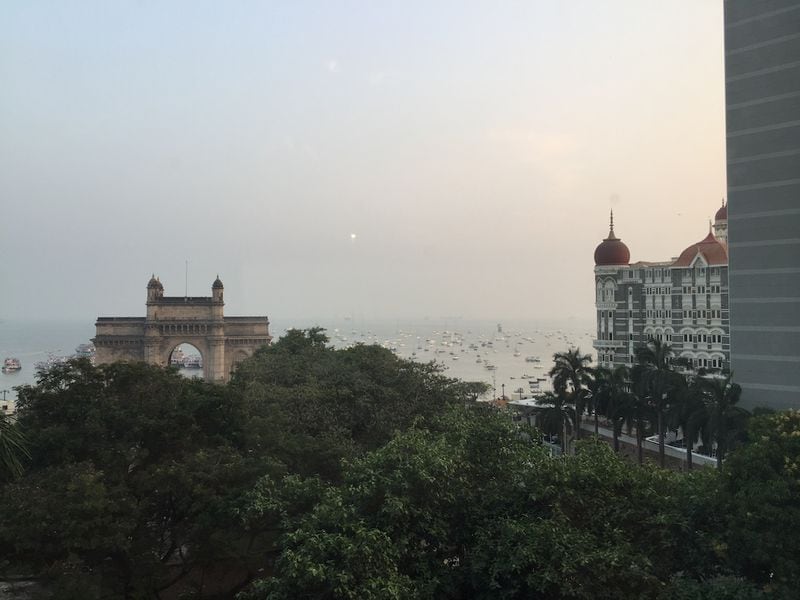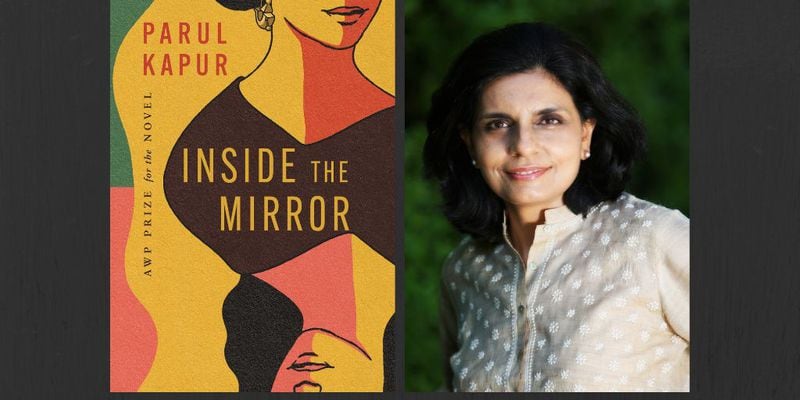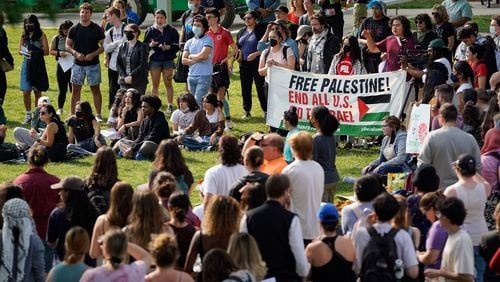This story was originally published by ArtsATL.
The seeds of Parul Kapur’s debut novel, “Inside the Mirror,” were first planted during her childhood, in the stories she heard of her father’s India. They took root years later, in the 1980s, during Kapur’s time as a journalist at Bombay, the magazine where she covered the city’s art scene.
In “Inside the Mirror” — a lush, evocative tale of twin sisters living in Bombay in the nascent years after Indian independence — readers meet Jaya, a medical student who dreams of becoming a painter, and her sister, Kamlesh, a student of Bharata Natyam dance who dreams of performing on the stage and in the movies.
Set during the aftermath of the brutal 1947 Partition, “Inside the Mirror” contends with questions of identity and gender, history and becoming. Written in a language that is as lyrically lithe as a dancer’s steps, as vivid as wet paint on a white canvas, it asks: What price are we willing to pay to become our truest selves? It asks: What does it cost to become who we are?
Kapur was born in Assam, India, and grew up in the United States. A journalist, fiction writer, literary critic and founder of the ArtsATL book section in 2010, Kapur has had work appear in publications including Art in America, the New Yorker, Guernica, the Paris Review and the Los Angeles Review of Books.
She recently spoke to ArtsATL about writing “Inside the Mirror,” winner of the AWP Prize for the Novel, and about the transgressive power of art.
Editor’s note: Some responses have been edited for brevity and clarity.
Credit: Courtesy of Parul Kapur
Credit: Courtesy of Parul Kapur
Q: How did you first meet Jaya and Kamlesh? How did they first come to you?
A: It was several different elements coming together. My parents immigrated here [to the United States] when I was 8 years old, and, after I graduated from Wesleyan University, I went to India for some friends’ weddings and had this idea that I wanted to move back there.
I had also written my thesis when I was at Wesleyan, which was a collection of short stories. I think that’s when I realized how interested I really was in India. Every story I wanted to write was set in India.
My father was also a big storyteller, and he would tell me all kinds of incidents from his past. In a sense, the India that I lived in was his India, the India of the ‘50s and ‘60s, and my mind gravitated to that.
I also wanted to work in India as a journalist, and I was able to get a job at a city magazine in Bombay, which is now Mumbai. I was always interested in art, so I tended to write about exhibitions, galleries, artists. That was a very formative experience.
I think the idea of the twins came to me because there were no other Indian families where I was growing up in Connecticut in the ‘70s. We were the only Indian family in town, and then, when I was about 16 years old, another [Indian] family moved into town. My mother invited them over, and they had two little twin daughters. They were very cute, observant, asking a lot of questions like, “Why do people in the town do this? Why do people in the town drive cars like that?” They were just very smart and clever, and I was always kind of enchanted with them.
It was a combination of all those elements.
Q: “Inside the Mirror” is set in the late 1940s. This was a very transitional time in India — not just politically, but culturally as well, in regard to the country’s burgeoning modern art movement — the movement Jaya longs to be a part of. Tell us more about this time period and how you came to it as the historical setting for your book.
A: When I was covering exhibitions [for Bombay magazine], I went to an art show. I met a man there who was very famous; he was a legendary character in Bombay art circles. His name was Kekoo Gandhy, and he used to have a frame shop, and all these young artists, back in the ‘40s when they had just founded the Progressive Artists’ Group, they used to come to this frame shop.
He told me the genesis of this art movement, how this volatile man, F.N. Souza, was also a genius painter and had founded the Progressive Artists’ Group. It was the real first modern art group in India, founded the same year as Indian independence. It was this group of about six artists, and their whole ethos was that they don’t want to have anything to do with traditional Indian art. They would say things like, “It’s folkloric. It’s effeminate.”
They were breaking from that, and also did not want anything to do with British-style painting. [Souza said,] “We want to embrace European art, Picasso, abstraction, school of Paris.”
That whole movement was born in 1947. It interested me a lot, so I asked Gandhy if there were any women painters [in the group]. He said no. And I began to imagine if there had been.
Credit: University of Nebraska Press
Credit: University of Nebraska Press
Q: Early on in the book, you write, “Art is a dangerous thing.” Could you speak more about art’s relationship to power and gender and politics as they relate to the characters in the book?
A: To be an artist, you are putting forth your view of the world. Whatever images you offer, it’s yourself, but you’re also commenting or expressing something about what you see in the world.
And we talk about authority, right? An artist is asserting their authority because they are presenting their vision. In India — and here — in the 1950s, women were not expected to assert authority. They had to accommodate male power and authority, be in the background, take care of the home.
In the book, for Jaya, the art world was mostly men, men who were considered to be lower class. They wouldn’t have had a lot of esteem in society. They were very poor, those artists. The few who might’ve come from middle-class families, they didn’t make much money because no one had the money to buy paintings. Because India itself was impoverished.
So those men didn’t have much status, and then you’re a woman — especially Jaya, of a relatively good family — and you’re cavorting with the kind of men who are viewed as very suspect characters. That causes a lot of shame within your family. They were very judgmental about a woman, her reputation, that kind of thing. It wasn’t acceptable at all.
In terms of [Kamlesh], that’s a different art. In India, dance was very traditional — Bharata Natyam has roots going back thousands of years.
But then you had the modern period, and the British came. They outlawed Bharata Natyam because they claimed it was a temple dance. They said that the priests were corrupt, and they were using these dancers as prostitutes. That was all part of their gaslighting campaign, in a sense, to show that they were morally superior people. Colonial power always has to convince the people its ruling that it ought to be there.
For Kamlesh, who is one of the early students of Bharata Natyam after its revival, she’s studying a dance that had been [outlawed] and almost destroyed during British rule. And she comes from a North Indian Punjabi culture where this dance is not traditional. North India — that’s where I’m from — was very Islamized. And for a woman to show her body on stage and dance was considered very shameful.
But when you’re a woman, on stage, showing your body, you are also, in a way, claiming your power, right? Claiming your physical power. That transgresses the boundaries of what women were expected to do.
Q: Jaya and Kamlesh are our main characters, but I’d love to hear more about their grandmother, Bebeji. We meet her as a very traditional grandmother figure but soon learn that this woman was a political activist, a powerful freedom fighter who spoke out against the British.
A: I wanted her to show the weight of the past, this horrendous, traumatic partition, the end of colonial rule.
Partition decimated the country, and I wanted Bebeji to carry the weight of what happened, the trauma of it, the hurt, the pain, the loss. Because if I only had these sisters, they’re young. When you’re very young, you don’t really have a sense of history, even if you lived through it. You’re just not knowledgeable enough.
I wanted her to [represent] what India had just emerged from.
Q: What does the title of the book, “Inside the Mirror,” mean to you as it relates to this notion of identity, the construction of self, to the idea of perception and being perceived?
A: The most simple way [to look at it] is that art is a mirror of the world. And so you could say I was inside the mirror or behind it, meaning I was asking: How is art made, and out of what circumstances does it grow? What does it arise from?
“Inside the Mirror” is also a very personal thing because when I was little, I would always look at myself in the mirror and be like, “Who is that person?” You live in your interior world, and then you see an image of yourself, so it’s kind of like a desire for self-knowledge. Because it was almost like looking at a stranger.
Q: What kinds of questions were you asking yourself about identity, and art and the world as you were writing “Inside the Mirror,” and did completing the book help you answer any of those questions?
A: When I started this book, I was a little older than these sisters. I was in my early 20s, and Jaya’s great determination to be a painter, her doubt and her searching — all of that was my own fears, doubts, desires, ambitions. I had all of those about writing. So I think I was looking at it through [the question] of, “How does a woman become who she wants to be?”
The book has been revised quite a bit. When I first wrote it, there were less obstacles, less societal shaming, because I didn’t really want anything to be in Jaya’s way. I wanted to get her where she wanted to go.
All of the obstacles came later, as I studied more about what actually happened to some of these artists and as I became the age of her parents. It was like experiencing her full arc.
What I couldn’t see when I was younger, I was able to see later.
::
Beth Ward is an Atlanta-based writer and editor. Her work has appeared in numerous publications, including The Rumpus, Hyperallergic, Atlas Obscura, BUST magazine, The Bitter Southerner, Atlanta magazine and Burnaway. Learn more about her work at www.bethwardwriting.com.
Credit: ArtsATL
Credit: ArtsATL
MEET OUR PARTNER
ArtsATL (artsatl.org) is a nonprofit organization that plays a critical role in educating and informing audiences about metro Atlanta’s arts and culture. ArtsATL, founded in 2009, helps build a sustainable arts community contributing to the economic and cultural health of the city.
If you have any questions about this partnership or others, please contact Senior Manager of Partnerships Nicole Williams at nicole.williams@ajc.com.
About the Author









